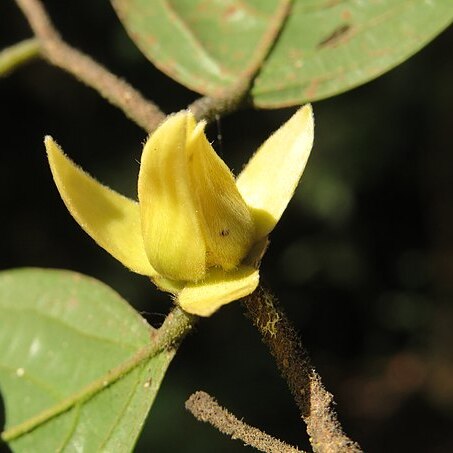Shrubs or small trees, unarmed, with simple hairs. Flowers bisexual, mostly axillary, solitary or a pair, or (not in Australia) in few-flowered cymes. Bracts 2–4. Sepals mostly valvate in bud, free or shortly connate at base, usually persistent in fruit. Petals mostly 6 in 2 similar series of 3 or inner ones slightly smaller, free, valvate or shortly imbricate at apex in bud; inner petals grooved or warted on inner surface near base, often not as widely spreading at maturity as outer petals. Stamens broadly wedge-shaped with a broad, truncate, oblique, shield-like connective tip concealing anther cells and more elongated near carpels. Pollen grains solitary. Carpels up to 16; ovules 3–16, superposed; stigma sessile or subsessile, mostly subglobular, obconical, or obovoid, obliquely attached, sparsely hairy or glabrous. Apocarps obloid, ellipsoidal or subglobular, shortly stipitate, sometimes umbonate at apex, usually not constricted between seeds when fresh, indehiscent. Seeds ellipsoidal or discoid to subglobose with a medial groove, 1–9, brown, surface variously undulate to rugulose. [The above description from the Flora of Australia Volume 2 (Jessup 2007: 51) requires revision since Fitzalania has been merged into Meiogyne-Editor, 7 June 2021.] Fitzalania (Jessup 2007: 45): Shrubs or small trees, unarmed. Shoots and branchlets densely hirsute or pubescent. Flowers bisexual, axillary, sometimes terminal, solitary. Sepals valvate, free or 2 partially connate, caducous or persistent to near mature fruit. Petals free; outer petals imbricate or not; inner petals imbricate, saccate towards tip, shortly clawed at base. Stamens wedge-shaped, incurved; connectives broad, truncate but not concealing anther cells due to high profile of receptacle. Pollen grains solitary. Carpels 5–10; ovules 5 or 6; stigma depressed-subglobular, sessile. Apocarps ellipsoidal, sessile, pubescent, orange-yellow. Seeds up to 6, transverse, ellipsoidal, or discoid, brown, shallowly punctate and undulate.
More
Shrubs [or trees], with simple hairs. Leaves with closely spaced oblique secondary veins. Inflorescences axillary, 1-3-flowered. Flowers bisexual. Torus conic. Sepals 3, valvate, united at base. Petals 6, in 2 whorls, with each whorl valvate, flat; outer petals slightly longer than or ± as long as inner. Stamens many; anther locules cuneate; connectives apically rhomboidal. Carpels 2-7(-12), sessile, villous; ovules several per carpel, in 2 series; stigmas sessile, subcapitate. Fruit apocarpous; monocarps 1-3[-5], usually sessile, ovoid [oblong or ellipsoid]. Seeds [several to] many per monocarp.

